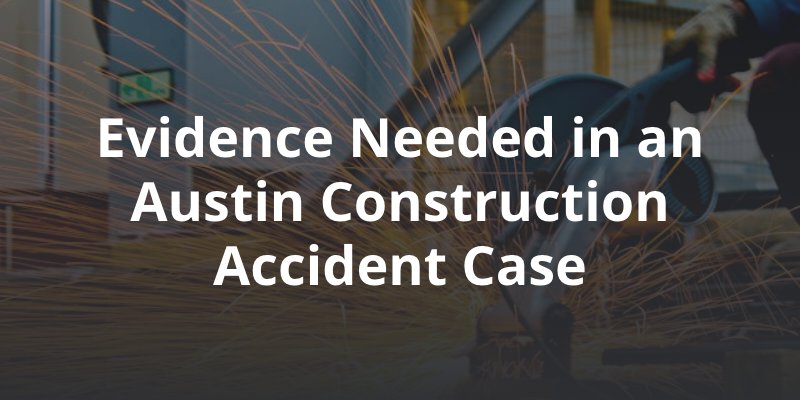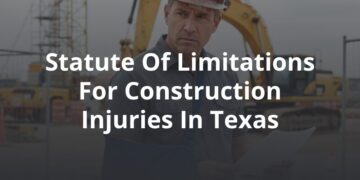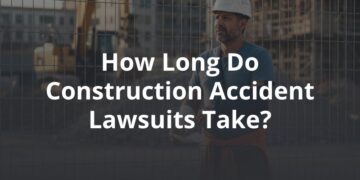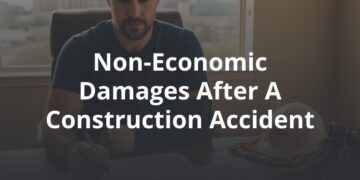
Construction is a highly dangerous industry that sees a large number of annual worker injuries and deaths in Texas. Most of these devastating incidents are preventable and caused by someone’s negligence, or the failure to act with the proper amount of care.
After a serious construction site accident in Austin, victims and their family members may be able to recover financial compensation for their related losses. To win a construction accident case, however, there must be evidence. Working with an experienced Austin construction accident lawyer can make a critical difference in proving your claim.
What Is Evidence?
Evidence refers to documents, physical or tangible items, and information used to prove a claim that is being made in a legal case. Evidence is key in a construction accident claim, as the plaintiff or injured party is required to prove the facts of the case as more likely to be true than not true.
This burden of proof is referred to as a “preponderance of the evidence.” Only when the burden of proof is met using compelling evidence will a plaintiff be awarded financial compensation from a defendant, or accused party, in a construction accident case. The strength of supporting evidence can determine the outcome of the claim.
Medical Records and Proof of Injury
Injury documentation is a critical part of a construction accident case in Austin. Without clear proof of injury, an insurance company will not accept a claim seeking financial compensation for medical bills, lost wages and other injury-related losses.
Document your construction accident injuries with evidence such as:
- Medical records
- Diagnostic test results
- X-rays and medical imaging
- Health care bills and expenses
- Notes from health care providers
- Independent Medical Evaluation (IME) evidence
- Medication prescriptions
- Reports from specialists
- Treatment plans
Medical evidence should prove the existence of an injury, show the connection between the injury and the construction accident, demonstrate the severity of the damage, and document your prognosis for recovery. Working with life care planners and medical experts can provide evidence of long-term harm, disability, or scarring and disfigurement.
An Incident Report
A construction site accident should always be reported to an employer right away, but at least within 30 days of the incident to qualify for workers’ compensation benefits. Notifying a supervisor of the construction accident will result in an incident report, which can be used as evidence for a claim. The report will contain details such as the date, time and location of the accident, as well as who was involved and the injuries that were suffered.
Photos and Video Documentation
Photographic evidence can be vital to a construction accident case, as it can provide unbiased, irrefutable proof of fact. If you can, take photos of the accident scene, being sure to capture any environmental hazards or defects that may have contributed to your injury. Take photos of visible injuries, as well.
Look around for surveillance or security cameras that may have caught the construction accident on tape. If there are any cameras, request a copy of the recordings from the employer or property manager. Video evidence can show how and why the construction accident happened.
Eyewitness Statements
Recorded or written statements from eyewitnesses can paint a fuller picture of what happened before, during and after a construction site accident in Austin. People who witnessed the accident – such as coworkers or contractors – may have a unique perspective of events, which can help provide proof of fault. Speak to eyewitnesses after your accident, if possible, and write down their names and contact information.
Proof of Lost Wages
If you are seeking financial benefits to replace wages you lost while you were in recovery – or future wages lost due to a permanent injury – you will need to provide the insurer with evidence of this specific type of monetary loss. This may include your relevant tax documents, paystubs, employment records and communications with your employer.
A workers’ compensation claim in Texas can result in benefits to replace around two-thirds (67 percent) of lost wages if you cannot return to work, while a personal injury suit could provide backpay for 100 percent of your lost wages.
Evidence of Negligence (for a Lawsuit)
When a harmful construction accident takes place in Austin, an injured worker has various legal rights and protections. If the victim’s employer has workers’ compensation insurance, a claim can be filed for no-fault financial benefits. If someone else is at fault for the accident, however, a personal injury claim may result in greater compensation.
For a successful construction accident lawsuit, you or your attorney will need to prove negligence, meaning someone failed to act with proper care. Proof of negligence may involve:
- Workplace safety compliance violations
- Safety logs and Occupational Safety and Health Administration (OSHA) reports
- Employer and worksite records
- Previous safety complaints filed against the employer
- Employee training records
- Property or equipment maintenance and inspection reports
If negligence such as poor worker training, a dangerous work environment, inadequate maintenance or lack of protective equipment is identified, this could place liability for the construction accident on an employer. A third party could also be found at fault depending on the circumstances, such as a contractor, subcontractor or property owner.
Product-Related Evidence
Many construction accidents in Texas are traced back to defective and dangerous products. Construction jobs deal with heavy machinery and dangerous equipment, such as cranes, scaffolding, forklifts and power tools.
If a product has a manufacturing, design or marketing defect, this can put construction workers at risk. A product liability claim after a construction accident in Austin can hold a manufacturing company or distribution center responsible for a worker’s injuries or death.
Most of these cases involve the doctrine of strict liability, meaning proving negligence is not necessary. Evidence to support a product liability case can include pictures of the defect, product recall notices and the defective item itself.
Expert Testimony
A strong type of evidence in a construction accident case could be expert witness testimony. An expert witness is a professional hired for in-depth knowledge of a specialized subject. A construction safety training expert, for example, could comment on the standards of care an employer should have used. Expert witnesses can make complex concepts clearer to judges and juries to help prove a claim.
For assistance building your construction injury claim in Austin with compelling evidence, contact FVF Law Firm to speak to an experienced Austin personal injury attorney. We have over 100 years of combined experience.







